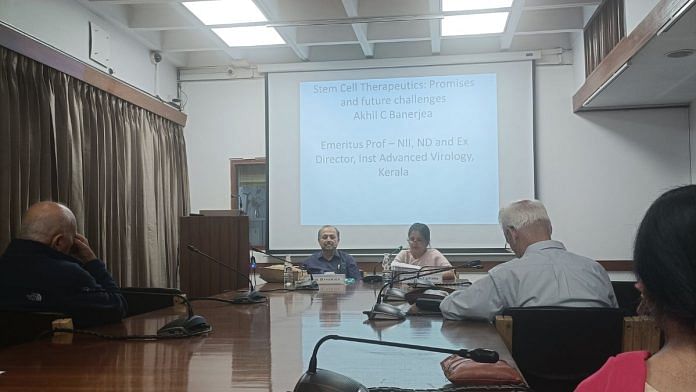New Delhi: Stem cells were meant to be the magic beans that would cure cancer, treat Alzheimer’s, and fix damaged tissue. But after decades of hype around these special human cells that can develop into many different cell types, there are no mind-boggling treatments available to patients. “It continues to be cosmetic, experimental and expensive,” said Dr. Akhil Banerjea, emeritus professor at the National Institute of Immunology during a lecture, Stem Cell Therapeutics: Promises and Future Challenges, at Delhi’s India International Centre.
What was supposed to be a talk on the future avenues of stem cell therapy ended up being a discussion on the history of stem cell research and its—so far—limited success in modern medicine. The ethical and moral complexities over stem cell research have been the centre of much debate with fears of cloning and the ethics of using embryonic stem cells. Banerjea’s lecture was measured, less of a hyperbole and rooted in science. Most of the audience members–there were around 20 people —were doctors and researchers.
Despite not making advancements in precision medicine, stem cell research is still extremely useful to scientists and biologists alike.
The unique factor in stem cells is they can regenerate, and can also transform into any cell type—such as blood, liver, or nerve cells. That is the ‘excitement’ associated with this therapy, which has been around since 1959 when the first bone marrow cell transplant was done in a patient suffering from leukaemia.
Banerjea’s presentation, which the scientific community concurs with, revealed that bone marrow transplant remains the only existing mainstream stem cell treatment. Ethical concerns with stem-cell generation, research barriers and even technical issues about how bodies will accept/reject stem cells are what’s holding back stem-cell therapy from taking over the medical industry.
“However, it is an ongoing field, and who knows what future research will reveal,” he said.
Also read: Human-based tech replacing animal testing in drug development. India must join in
Ethical concerns
As Banerjea delivered his address on the mechanics behind stem cells, and the different kinds of cells, audience members kept returning to their potential. “What about cancer and heart attacks?” asked one young medical student. “What about Alzheimer’s and dementia? Is stem-cell therapy the answer?” piped up another.
Taking a systematic approach, Banerjea first explained how there are different types of stem cells like adult stem cells, which are regenerative stem cells that exist in different organs. They can only produce more cells of that particular type. Then there are embryonic stem cells that are pluripotent—which means they can regenerate and transform into almost every cell type and be used for a wider range of therapies.
“It is with embryonic stem cells that ethical concerns come up,” said Banerjea. Using embryos to harvest stem cells is quite a controversial subject in most countries, especially the United States and it has divided the medical community on the feasibility of using embryos for stem-cell therapy.
In 2006, Dr Shinya Yamanaka’s laboratory came up with a method to convert adult stem cells into pluripotent stem cells—thus eradicating the ethical concern of using embryonic stem cells. It was seen as “breathing new life” into the field of stem-cell therapy. But the potential and promise has yet to become a reality.
Banerjea said that even this advancement was mired in debate, starting from the conversion method itself.
“We introduce four genes to convert an adult stem cell into iPSC (induced pluripotent stem cell). This leads to rapid regeneration of these cells—I mean, you can grow and fill your buckets with these cells,” he said, displaying a picture of pluripotent stem cells he had created using this method during a research stint at Colorado State University.
But this is also where the problem lies—this rapid proliferation of stem cells also poses the risk of it turning into cancer.
A research paper by Yamanaka in 2020 also examined this fallout, the risk of cancer and the bigger problem of immunogenicity—the immune response that foreign cells in the body might evoke. For this reason, Banerjea said that governments across the world look at stem cell research with caution. It’s difficult for most stem-cell therapies to make it to the clinical trial stage.
Despite all his examples to the contrary, Banerjea remains optimistic. Stem-cell therapy remains a landmark medical advancement and has a “bright future” for curing long-term illnesses.
“It has helped cell biologists enormously. Once we understand cell pathways and reactions, we attempt to make cell-based therapies,” said Banerjea.
(Edited by Theres Sudeep)



